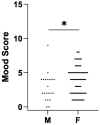Temporo-Mandibular Joint Functional Arthroplasty: Does It Improve the Short-Term Quality of Life in Patients with Painful Anterior Disc Displacement Without Reduction? A Retrospective Cohort Study
- PMID: 40283391
- PMCID: PMC12028087
- DOI: 10.3390/jcm14082560
Temporo-Mandibular Joint Functional Arthroplasty: Does It Improve the Short-Term Quality of Life in Patients with Painful Anterior Disc Displacement Without Reduction? A Retrospective Cohort Study
Abstract
Background: Anterior disc displacement without reduction (ADDwoR) of the temporomandibular joint (TMJ) often leads to persistent pain and reduced quality of life (QoL). Conservative treatments frequently fail to provide adequate symptom relief. Objective: To assess the short-term (≥6 months) effectiveness of functional arthroplasty in reducing pain and improving QoL in patients with ADDwoR unresponsive to conservative therapies. Methods: A retrospective cohort study was conducted on 105 patients (median age 38 years, 80% female) treated at Santa Maria Hospital from January 2018 to December 2021. All patients had unilateral painful ADDwoR confirmed via MRI and underwent functional arthroplasty. Primary outcomes included pain reduction (VAS) and QoL improvements (QoL-TMJ questionnaire). Covariates such as age, gender, and baseline mood disturbances were analyzed for associations with surgical outcomes. Statistical analyses included the Wilcoxon rank test, Friedman's ANOVA, and Spearman's rank correlation. Results: Postoperative VAS scores significantly decreased (8.0 pre-op vs. 2.0 post-op, p < 0.001). QoL-TMJ scores improved significantly in pain (p < 0.001), activity (p < 0.05), mood (p < 0.001), and anxiety (p < 0.01), but no significant changes were observed in chewing and speaking functions. Improvements in QoL correlated strongly with pain reduction. Gender and age did not influence the outcomes, though females reported higher baseline mood disturbances. Conclusions: Functional arthroplasty effectively reduces pain and improves QoL in patients with ADDwoR, regardless of age or gender. However, limited improvement in chewing and speaking abilities highlights the need for targeted interventions. Future studies should assess the long-term outcomes to confirm the sustained benefits of this procedure.
Keywords: functional arthroplasty; quality of life; temporomandibular joint.
Conflict of interest statement
The authors declare no conflicts of interest.
Figures






Similar articles
-
[A three-dimensional imaging study of the effect of anterior disc displacement on the bony structural relationship of the temporomandibular joint].Zhonghua Kou Qiang Yi Xue Za Zhi. 2024 Feb 9;59(2):157-164. doi: 10.3760/cma.j.cn112144-20230718-00015. Zhonghua Kou Qiang Yi Xue Za Zhi. 2024. PMID: 38280823 Chinese.
-
[Analysis of the correlation between chewing side preference and disc displacement types and clinical symptoms in patients with anterior disc displacement of temporomandibular joint].Zhonghua Kou Qiang Yi Xue Za Zhi. 2021 Aug 9;56(8):753-758. doi: 10.3760/cma.j.cn112144-20210119-00029. Online ahead of print. Zhonghua Kou Qiang Yi Xue Za Zhi. 2021. PMID: 34404140 Chinese.
-
Clinical outcomes of patients with bilateral anterior disc displacement without reduction and erosive change of the temporomandibular joint after performance of unilateral arthrocentesis and stabilisation splint therapy.J Oral Rehabil. 2020 Mar;47(3):307-312. doi: 10.1111/joor.12897. Epub 2019 Oct 20. J Oral Rehabil. 2020. PMID: 31557342
-
Comparison between disc repositioning by open surgery versus occlusal splint in the treatment of temporomandibular joint anterior disc displacement without reduction: A retrospective cohort trial of short-term results.J Craniomaxillofac Surg. 2023 May 15:S1010-5182(23)00071-9. doi: 10.1016/j.jcms.2023.04.009. Online ahead of print. J Craniomaxillofac Surg. 2023. PMID: 39492054
-
Behavioural modification interventions for medically unexplained symptoms in primary care: systematic reviews and economic evaluation.Health Technol Assess. 2020 Sep;24(46):1-490. doi: 10.3310/hta24460. Health Technol Assess. 2020. PMID: 32975190 Free PMC article.
References
-
- Miloro M., Ghali E.G., Larsen E.P., Waite P. Peterson’s Principles of Oral and Maxillofacial Surgery. 4th ed. Springer; Berlin/Heidelberg, Germany: 2022.
LinkOut - more resources
Full Text Sources
Miscellaneous

